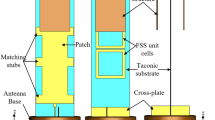Abstract
Printed circuit board antennas degrade considerably when the wireless node is placed on or near metallic surfaces. One such application is wireless alarm network where nodes are placed on a metallic fence. As wireless transmission is regarded as the most expensive operation in terms of sensor node energy, it is more than a necessity to have a good antenna design. We simulate the performances of typical printed circuit board (PCB) antennas with proximity to metallic fence and simulations show that traditional antenna structures exhibit poor performance for these applications. Instead, we propose a low-cost two-antenna diversity system that utilizes two PCB antennas with different radiation pattern coverage. Antenna diversity by means of radio frequency switches was implemented for two configurations: single state antenna selection and equal-gain diversity combination. Diversity gains were calculated for free-space and over-the-fence operating conditions, and the best antenna configuration is suggested for practical applications.















Similar content being viewed by others
References
Anastasi, G., Conti, M., Francesco, M., & Passarella, A. (2009). Energy conservation in wireless sensor networks: A survey. Ad Hoc Networks, 7(3), 537–568.
Dietrich, C. B, Jr, Dietze, K., Nealy, J. R., & Stutzman, W. L. (2001). Spatial, polarization, and pattern diversity for wireless handheld terminals. IEEE Transactions on Antennas and Propagation, 49(9), 1271–1281.
Foschini, G. J., & Gans, M. J. (1998). On limits of wireless communications in a fading environment when using multiple antennas. Wireless Personal Communications, 6, 311–335.
Leather, P. S. H., & Parsons, D. (2003). Antenna diversity for UHF hand portable radio. Electronics Letters, 39(13), 946–948.
Chang, D.-C., Zeng, B.-H., & Liu, J.-C. (2009). Reconigurable angular diversity antenna with quad corner reflector arrays for 2.4 GHz applications. IET Microwaves, Antennas & Propagation, 3(3), 522–528.
Lai, M.-I., Wu, T. Y., Hsieh, J. C., Wang, C. H., & Jeng, S. K. (2008). Compact switched-beam antenna employing a four-element slot antenna array for digital home applications. IEEE Transactions on Antennas and Propagation, 56(9), 2929–2936.
Zhang, S., Hu, G. H., & Bernhard, J. T. (2004). A pattern reconfigurable microstrip parasitic array. IEEE Transactions on Antennas and Propagation, 52(10), 2773–2776.
Giorgetti, G., Cidronali, A., Gupta, S. K. S., & Manes, G. (2007). Exploiting low-cost directional antennas in 2.4 GHz IEEE 802.15.4 wireless sensor networks. In Proceedings of the 10th European Conference on Wireless Technology.
Luca, C., Guglielmi, S., Patrono, L., & Tarricone, L. (2013). Switched beam antenna for wireless sensor network nodes. Progress in Electromagnetics Research C, 39, 193–207.
http://www.ti.com/lit/an/swru120b/swru120b.pdf Last accessed Feb 25th, 2014.
Kildal, P.-S., Rosengren, K., Byun, J., & Lee, J. (2002). Definition of effective diversity gain and how to measure it in a reverberation chamber. Microwave and Optical Technology Letters, 34(1), 56–59.
Taga, T. (1990). Analysis for mean effective gain of mobile antennas in land mobile radio environments. IEEE Transactions on Vehicular Technology, 39(2), 117–131.
Blanch, S., Romeu, J., & Corbella, I. (2003). Exact representation of antenna system diversity performance from input parameter description. Electronics Letters, 39(9), 705–707.
Kildal, P.-S., & Rosengren, K. (2003). Electromagnetic analysis of effective and apparent diversity gain of two parallel dipoles. IEEE Antennas and Wireless Propagation Letters, 2, 9–13.
Kong, N., & Milstein, L. B. (1999). Average SNR of a generalized diversity selection combining scheme. IEEE Communications Letters, 3(3), 57–59.
Kong, N., & Milstein, L. B. (2000). SNR of generalized diversity selection combining with nonidentical rayleigh fading statistics. IEEE Transactions on Communications, 48, 1266–1271.
Author information
Authors and Affiliations
Corresponding author
Rights and permissions
About this article
Cite this article
Bilgiç, M.M., Yeğin, K. Diversity Antenna Design for Wireless Alarm Networks. Wireless Pers Commun 78, 729–740 (2014). https://doi.org/10.1007/s11277-014-1780-5
Published:
Issue Date:
DOI: https://doi.org/10.1007/s11277-014-1780-5




